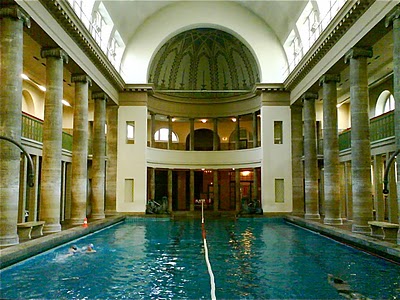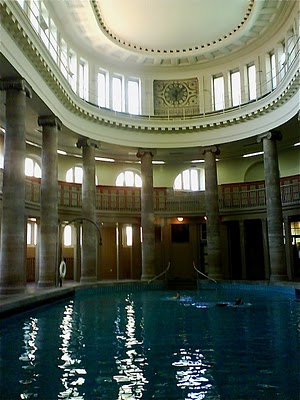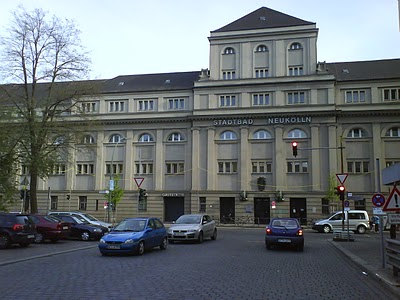 Berliners are not nostalgic. There is public outcry when architects propose to build in a nostalgic style (the re-construction of the Stadtschloss is the current focal point of concern). For what did the German past lead to? Militarism, Expansion, Racism and the Camps. After WW2, people either wanted to forget or understand what went wrong.
Berliners are not nostalgic. There is public outcry when architects propose to build in a nostalgic style (the re-construction of the Stadtschloss is the current focal point of concern). For what did the German past lead to? Militarism, Expansion, Racism and the Camps. After WW2, people either wanted to forget or understand what went wrong.
It is 1914, the last gasp of Imperial Germany, and we enter a completely different mentality: a recently unified country used to winning wars. German archaeologists are digging up the ancient world in the Middle East. High schools are still teaching Greek and Latin, a requirement for university. Germany draws on the classical past for imperial legitimacy and cultural prestige, and its public monuments reflect that nostalgia.
Take architect, Reinhold Kiehl, a public building inspector who was responsible for the Rathaus Neukölln (1908), the seat of neighbourhood governance built in a German Renaissance style, and for the neighbourhood’s public baths, the Stadtbad Neukölln (1914).
Kiehl built with the imagination of the 19th Century, the baths are a Classical Temple to physical fitness. It was largest facility of its kind in its day. There is a large pool and a small pool, with vaulted roofs, mosaics and ionic colonnades. And there is the Sauna area, copied from Pompei, with the requisite hot and dry chambers, pools of varying temperatures, an exercise in pushing the body by degrees.
Prejudice tells me I should hate swimming here. I don’t like derivative architectural exercises, do I? No one else does either, I surmise. I have the pool almost to myself. Beautiful bodies stare down at me from the mosaics. I slip under water and for just a moment the lines coalesce and I can imagine they are are real, that Germany moved forward into that imagined more distant past, instead of the one we know.

After my swim, I relax in the dry sauna. There is an Aufguss. The door is closed and the patrons sit and sweat together while the Aufgussmeisterfans superheated air over their sweating bodies. He hears me speak English to my partner, and the patrons, mostly old men, comment as if we cannot understand — comments about foreigners which are not entirely friendly. One then jokes about Foreign Minister Westerwelle, about his terrible English-language skills. And another jokes about him being gay. I look around and notice that although we are in a neighbourhood that is now primarily Turkish and Arabic, everyone around me is white. The temperature increases, a strange vapour seems to rise about me, and I find it hard to breathe.
When the door finally opens, I am dizzy and parched. I find myself circling the Pompeian replica. I cannot find the exit, and when I do, I fumble with the handle. I need to escape outside. I want to surface, I need oxygen. I want out of the past. The handle turns and then there is a wave of relief. I cross the threshold.
** 12/2011: I have since been back to the Stadtbad Neukölln many times and to my amazement it has become one of my favourite places. The atmosphere has relaxed and I see my first experience evaporating like the steam.
Größere Kartenansicht
 Berliners are not nostalgic. There is public outcry when architects propose to build in a nostalgic style (the re-construction of the Stadtschloss is the current focal point of concern). For what did the German past lead to? Militarism, Expansion, Racism and the Camps. After WW2, people either wanted to forget or understand what went wrong.
Berliners are not nostalgic. There is public outcry when architects propose to build in a nostalgic style (the re-construction of the Stadtschloss is the current focal point of concern). For what did the German past lead to? Militarism, Expansion, Racism and the Camps. After WW2, people either wanted to forget or understand what went wrong.



Does this sauna offer the opportunity to rent towels or is it necessary to bring your own?
You can rent a large sauna towel when you arrive downstairs for slightly less than 2 EUR. But you will be charged a 10 EUR deposit on it, along with another 10 EUR deposit for the sauna entry bracelet (entry itself is 14 EUR). So count on 36 EUR entry, but you get 20 EUR of that back when you leave.
Thanks – beautiful pools and saunas – surprisingly for germany this was the first time I had noticed people talking in the sauna, including during the aufguss – really annoying !
Worth mentioning that on Saturday evening the smaller pool is FKK so you can go straight from the sauna to the pool without having to bother about swim wear.
How much is the entrance?
Prices for the Stadtbad Neukölln currently are roughly:
-11 EUR entry (less if you’re a student), + 10 EUR deposit for the wristband (you get the deposit back when you leave). —It’s another 2 EUR or so if you want a big towel + another 10 EUR deposit (you get it back when you return the receipt you exchanged for the towel upstairs).
-Bring two 1 EUR coins for the lockers: one upstairs for changing, another upstairs in the sauna for valuables, and so you can pay for drinks and food if you want it.
-Bring your own water bottle to fill up from the sink upstairs, to save money. The staff don’t mind.
-I always like the feeling of getting back 20 EUR in deposit at the end of the night, makes me feel rich!